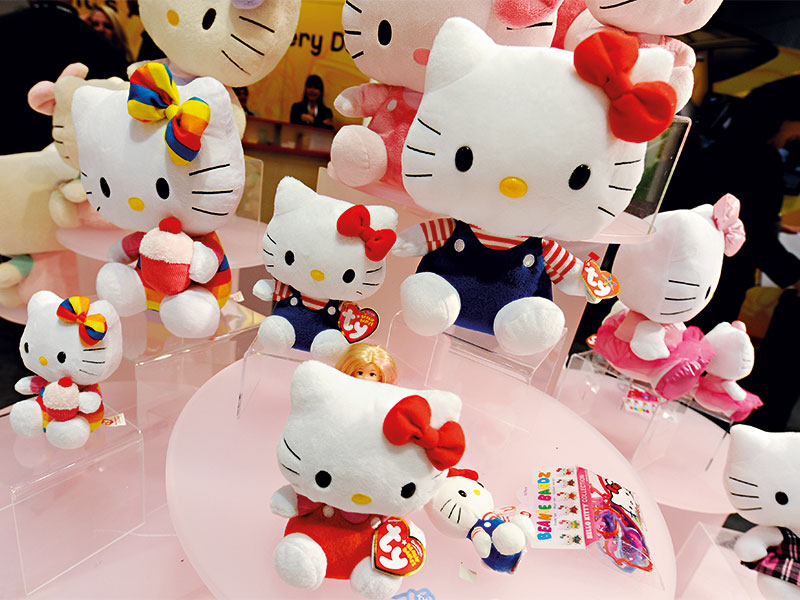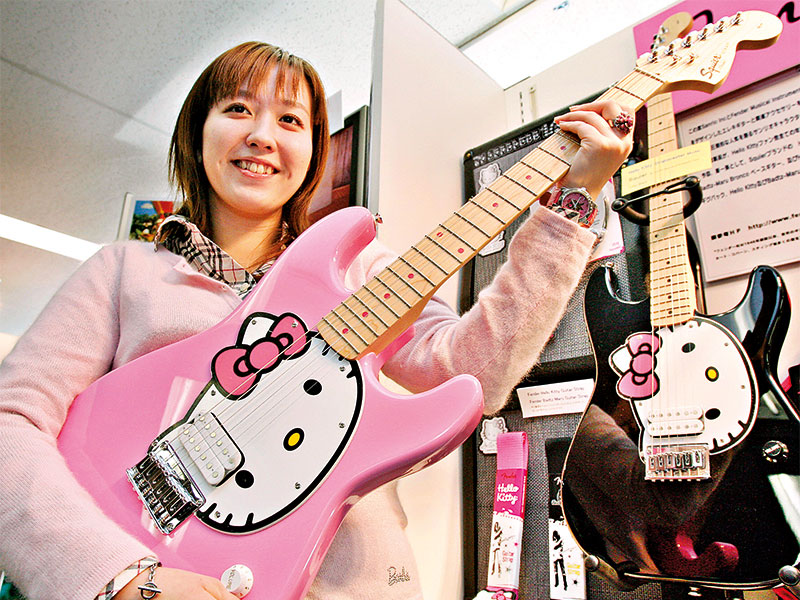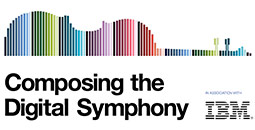Hello Kitty is taking over the world, one product at a time
In Hello Kitty, Sanrio has created a $7bn brand that is adored the world over. But just how did an expressionless cat-girl become so wildly popular?

Hello Kitty branded products are ubiquitous - the cute face is plastered on almost every product imaginable
Hello Kitty is not a cat. The world’s most famous kitten is, in fact, a little girl from London. She has a twin sister called Mimmy, her hobbies include baking and playing tennis, and she even has her own pet cat called Charmmy Kitty.
Kitty White, known to the world as Hello Kitty, is a global phenomenon, an iconic brand, a subject of devotion and obsession, and the centrepiece of one of the most successful marketing models of the past century. But she’s not a cat.
Since the creation of Hello Kitty, Sanrio, the company behind its success, has soared to incredible heights, carving out a presence in over 70 countries with a character that is adored by children and adults alike. Today, the brand is worth over $7bn, and features on more than 50,000 products worldwide. The appeal of Hello Kitty knows no limits, spanning continents, cultures, ages and genders, with its fanbase growing rapidly with each passing year. Indeed, the brand is the perfect illustration of how simplicity and versatility can weave magic, and how a careful balance of consistency and keeping abreast of cultural changes is perhaps the only way to ensure longevity.
Kawaii culture
Hello Kitty was created in 1974 by Yuko Shimizu, an employee of consumer goods company Sanrio, who was tasked with designing six new characters for the company. By March the following year, a small vinyl purse – the first piece of merchandise to carry the now-iconic Hello Kitty visage – was sold. The character was an instant hit, as Sanrio had cleverly played into a nascent trend in 70s Japan.
“It was the rise of girl culture, if you will”, said Christine Yano, Professor of Anthropology at the University of Hawaii, and the author of the only academic book on the subject: Pink Globalisation: Hello Kitty’s Trek Across the Pacific. “Sanrio tried out this notion of cute add-ons to things. For example, if you had simple beach sandals and you put a strawberry or a flower on them, all of a sudden it has added value, and the value in this case was decorative cuteness”.
Sanrio’s founder and CEO had a global vision in mind: with Hello Kitty, he hoped to create Japan’s answer to Mickey Mouse
Soon, these embellishments took on a life of their own, growing into cute characters in their own right. As most other animals already had representatives that were popular in Japan (Snoopy the dog, Mickey the mouse, and so on) Sanrio settled upon a cat. “And that took off, so Hello Kitty was born amid this rise in girl consumer culture in mid-70s Japan.”
The girl culture movement quickly became intertwined with the concept of kawaii, or cuteness, in Japanese popular culture. “Throughout the 80s and 90s, Hello Kitty was very kawaii, and played a huge part of the growth of kawaii in Japan”, noted Martina Longueira, Senior Marketing Manager at Sanrio. “Hello Kitty was really able to resonate with the concept of cuteness and femininity”.
The rise of cutesy culture mirrored the changing political and socioeconomic mood in Japan at the time, as the country underwent a profound shift from political idealism to mass-market consumerism. Sanrio’s ever-growing range of Hello Kitty-emblazoned fanshi guzzu (fancy goods) played perfectly into Japan’s newfound consumerism and emerging national identity, with masculinity and sobriety giving way to femininity and playfulness.
Cat for a mouse
From the very outset, Shintaro Tsuji, Sanrio’s founder and CEO, had a global vision in mind: with Hello Kitty, he hoped to create Japan’s answer to Mickey Mouse. “This was a Japanese version of an anthropomorphised animal figure”, Yano said. “And, in fact, the founder’s ambitions were that this cat might overtake the American mouse.” Reflecting these early ambitions was Sanrio’s swift move to the US, just two years after Hello Kitty was created. “That foray into the American market by way of Asian-American conclave stores was instantly successful among Asian-Americans.”
From the 80s onwards, Hello Kitty’s appeal began to defy ethnicity, with the character firmly in the universal consciousness by the 90s, particularly as celebrities began to associate with the brand. By appearing alongside the likes of Mariah Carey and Cameron Diaz, Sanrio and Hello Kitty were able to make “inroads into the American popular culture consciousness”, Yano noted. “It went from an Asian-American niche market to a much broader market, so that by the 90s Hello Kitty was fairly widespread and distributed to department stores.”
Hello Kitty’s popularity continued to mushroom across the globe, with merchandise proliferating at a stunning rate. In Taiwan, for example, there is now a Hello Kitty-themed maternity clinic and a Hello Kitty aeroplane – the latter thanks to national carrier EVA Air. Hello Kitty cafés and restaurants in London, California, Hong Kong and Singapore have queues around the block, while two theme parks in Japan and one in Shanghai pull in hundreds of millions in revenue each year. From the practical (rice cookers and waffle makers) to the expensive (diamond encrusted jewellery and laptops), to the unlicensed and bizarre (assault rifles and vibrators), it seems there is nothing you can’t buy without the expressionless feline staring back at you.
Nothing there
While Hello Kitty’s popularity can be put down to the rise of kawaii and broader cultural shifts, ensuring her compatibility with these trends was the masterstroke of her creation. Take a closer look at Kitty White and you’ll be struck by how simple and clean the motif is. As Yano put it: “The design has a brilliant abstraction.” This simplicity gives Hello Kitty incredible versatility as a logo; it can be moulded to fit any product.
Perhaps more importantly, the simplicity also speaks to the consumer; for them, the character is a mirror. “She can represent what you are feeling, or what you want her to share with you”, Longueira explained. “So, if someone is feeling sad, they’ll be able to look at Hello Kitty and believe that she’s empathising. If they are feeling happy, then Hello Kitty is there to share in happiness with them. There’s a simplicity to Hello Kitty that is a big part of why she remains so popular, and visually is so memorable and striking for the superfans or for the millions that are aware of her.”
While Hello Kitty’s popularity can be put down to the rise of kawaii and broader cultural shifts, ensuring her compatibility with these trends was the masterstroke of her creation
Not having a mouth is also an important element of the design and broad appeal. “She doesn’t have a mouth because she speaks from the heart and because it means that we don’t attribute a specific language or a specific localised set of values to her”, said Longueira. In Hello Kitty, Sanrio has a blank slate that can be adapted to any culture, market or product. “There is a huge range of products and marketing out there by Sanrio – it’s phenomenally diverse. I think Sanrio has always been very creative about how we can make Hello Kitty come to life and how she will be most relevant in different parts of the world.”
“People have talked about Hello Kitty blankness: the ability to have such a blank slate that you can project anything onto her”, Yano agreed. “This is different to other characters like Mickey Mouse, which are already so filled with content, making it more difficult to project your feelings. Hello Kitty is, in some ways, contentless, which offers great flexibility in terms of who this is supposed to be, what it is supposed to represent, and especially what it might mean to me: the consumer. In a sense, there are many, many Hello Kittys out there, each a kind of mirror enabled by its simplicity and abstraction.”

Big kids
What is particularly striking about the appeal of Hello Kitty is that, despite starting out as a children’s character, the brand has become incredibly popular among adults as well. Indeed, Hello Kitty inspires a certain level of mega-fandom that has seen many individuals procure vast collections, covering themselves and their homes in Hello Kitty merchandise.
Longueira suggested some of this infatuation among adults could be attributed to Hello Kitty’s longevity. “For children that saw Hello Kitty in the 70s, 80s and 90s, those girls, and some boys, are now adults. A 42-year-old woman will have known Hello Kitty her entire life. When you love something as a child, you will continue to love it, or have really positive feelings towards it, when you become an adult, and then you’ll probably share it with your own children as well.”
Yano argued a cultural shift in terms of what is socially acceptable among adults has also played a role: “I think Hello Kitty has come at a very interesting juncture, when we think cute girly things are OK. It’s a very fertile time for its market demographic, which as you know is now way beyond children.”
Sanrio’s company slogan is “small gift, big smile”, and this mentality underlies the appeal of Hello Kitty. “It’s about generosity, giving gifts in a small or big way, and making someone smile”, said Longueira. “The main tenet of the character and her whole story is around friendship and generosity; there is a purity and innocence to her that resonates with people of all ages, wherever they are from. And the idea that she was created in order to share with others and give a gift is crucial.”
Test of time
What makes Sanrio’s success all the more impressive is the fact Hello Kitty has never been cast aside as a passing fad – the usual fate of illustrated characters. This may partly be due to the fact Hello Kitty’s popularity was not sparked by a TV show or film, for which a decline in popularity would naturally follow a post-release peak. “There isn’t a rotating series of pushes in that sense to make Hello Kitty fit a mould”, explained Longueira. “She’s kind of who she is because Sanrio believes she should be, so there isn’t a need to offer a new message around Hello Kitty in each market or every year, and because she has existed for so long, her identity is clear.”
When you love something as a child, you will continue to love it, or have really positive feelings towards it, when you become an adult, and then you’ll probably share it with your own children as well
Again, Hello Kitty’s blankness comes into play here, as it has afforded Sanrio incredible flexibility: the character defies fads and always stays cool. “She’s almost 45, and we’ve seen so much in terms of trends, cultural change and shifts in attitudes, and Hello Kitty has been there throughout”, said Longueira. “Due to both the company’s creative direction and the fact that Sanrio is present basically everywhere in the world, you can see where trends are beginning or where they lead to. This allows you to be ahead of the curve and also understand that maybe that curve will come full circle, which happens quite a lot.”
Hello Kitty’s ubiquity and status as a cultural icon has made her an obvious target for commercial partnerships. Indeed, more and more western companies are scrambling to team up with Sanrio and plaster their products with Hello Kitty branding. In 2006, iconic US guitar maker Fender released a Hello Kitty Stratocaster, with the likes of Guns N’ Roses guitarist Slash pictured playing the new pink guitar. In 2009, make-up giant Mac introduced a limited edition Hello Kitty range. “To me, Mac Hello Kitty embodies the ultimate beauty icon”, said Jennifer Balbier, Mac’s Senior Vice President of Product Development, at the time. The following year, carmaker Smart jumped on the bandwagon, introducing a variety of full and partial body wraps, allowing drivers to show the world their love for Kitty White.
When asked about this growing trend, Longueira explained there is more at play than simply partnering with a popular brand. “I think western companies and people in general look to Japan for a certain kind of design and cultural influence”, she said. “Japanese design is often associated with high quality; there’s a clean and pure element to it, and I think, in a really fascinating way, Hello Kitty represents that notion of Japanese culture and design that western companies can engage with.”
World domination
So, what remains for Kitty White? Well, while the main character is ubiquitous, her supporting cast remain largely in the shadows, but Sanrio now has plans to spread the brand even further by elevating the profile of the other characters in the company’s toy chest. “Hello Kitty has so many other figures around her that we’re really keen to expand, in order to reinforce the story of Kitty and her friends”, said Longueira. “There’s also a continuation of communicating Hello Kitty’s kindness and generosity. Sanrio works with charities and philanthropic partners; doing more in this area and working with more partners in more regions is a big part of reinforcing that central part of the Hello Kitty story.”
And that’s not all. While the male demographic in Japan has already been secured, Sanrio wants to replicate the feat globally. Hello Kitty has largely been perceived as a female brand, but the positive rise of the concept of gender neutrality is feeding the idea that anyone can be a Hello Kitty fan. Sanrio is attempting to capture the zeitgeist, just as it did when the character was launched. “I think the idea that we shouldn’t be pigeonholed to female or male boundaries is growing apace”, noted Longueira. “Hello Kitty has a lot of male fans and I think more men are confident in saying so. Ultimately, friendship and generosity are values that are important to all humans, regardless of gender or sexuality.”
While the male demographic in Japan has already been secured, Sanrio wants to replicate the feat globally.
Hello Kitty started out as part of the rise of kawaii culture, but has since demonstrated a remarkable ability to stay ahead of the curve. Over four decades, the brand has survived changes in fashion, society, technology and politics, remaining ever constant and largely unchanged. For this feat alone, Hello Kitty must be regarded as truly phenomenal. The character has become an integral part of people’s lives, triggering a sense of nostalgia and innocence that speaks to people of all ages, races and genders.
Sanrio’s success can be attributed in large part to the brilliance of Hello Kitty’s design, but in equal measure to the simplicity of the company’s global strategy. In Hello Kitty, Sanrio has created a mirror that reflects both individuals and societal trends – in many ways it’s the perfect commercial logo. As Kitty White adapts, her core message remains the same. This balance of consistency and evolution is incredibly fine; in managing it Sanrio has carved out a niche position that’s very tough to emulate. As the brand continues to flourish worldwide, it’s safe to say we won’t be saying Goodbye Kitty anytime soon.













